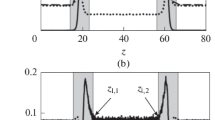Abstract
A method to determine Joule–Thomson inversion curves, using isobaric-isothermal Monte Carlo molecular simulations, is presented. The usual experimental practice to obtain the locus of points in which the isenthalpic derivative of temperature with respect to pressure vanishes is to process volumetric data by means of thermodynamic relations. This experimental procedure requires the very precise measurement of volumetric properties at conditions up to five times the fluid's critical temperature and twelve times its critical pressure. These harsh experimental conditions have hindered the publication of data for even simple fluids and mixtures. By using molecular simulation, these problems may be circumvented, since the computational effort is roughly independent of the actual value of the pressure or the temperature. In general, Joule–Thomson inversion curves obtained by molecular simulation may be used either as an unambiguous test for equations of state in the supercritical and high-pressure regions or for the prediction of real fluid behavior, should the potential be well known. Both applications are exemplified for a Lennard-Jones fluid for which the complete inversion curve is obtained.
Similar content being viewed by others
REFERENCES
W. G. Kortekaas, C. J. Peters, and J. de Swaan Arons, Fluid Phase Equil. 139:205 (1997).
R. D. Gunn, P. L. Chueh, and J. M. Prausnitz, Cryogenics 6:324 (1966).
D. G. Miller, Ind. Eng. Chem. Fundam. 9:585 (1970).
M. G. Castillo, C. M. Colina, J. E. Dubuc, and C. Olivera-Fuentes, Int. J. Thermophys., in press.
A. V. Colazo, F. A. Da Silva, E. A. Müller, and C. Olivera-Fuentes, Lat. Am. Appl. Res. 22:135 (1992).
Y. Song and E. A. Mason, J. Chem. Phys. 91:7840 (1989).
D. M. Heyes and C. T. Llaguno, Chem. Phys. 168:61 (1992).
R. Lustig, J. Chem. Phys. 100:3068 (1994).
C. M. Colina and E. A. Müller, Mol. Simulat. 19:237 (1997).
M. P. Allen and D. J. Tildesley, Computer Simulation of Liquids (Clarendon Press, Oxford, 1987).
J. K. Johnson, J. A. Zollweg, and K. E. Gubbins, Mol. Phys. 78:591 (1993).
J. Kolafa and I. Nezbeda, Fluid Phase Equil. 100:1 (1994).
A. Lofti, J. Vrabec, and J. Fischer, Mol. Phys. 76:1319 (1992).
Author information
Authors and Affiliations
Rights and permissions
About this article
Cite this article
Colina, C.M., Müller, E.A. Molecular Simulation of Joule–Thomson Inversion Curves. International Journal of Thermophysics 20, 229–235 (1999). https://doi.org/10.1023/A:1021402902877
Issue Date:
DOI: https://doi.org/10.1023/A:1021402902877




